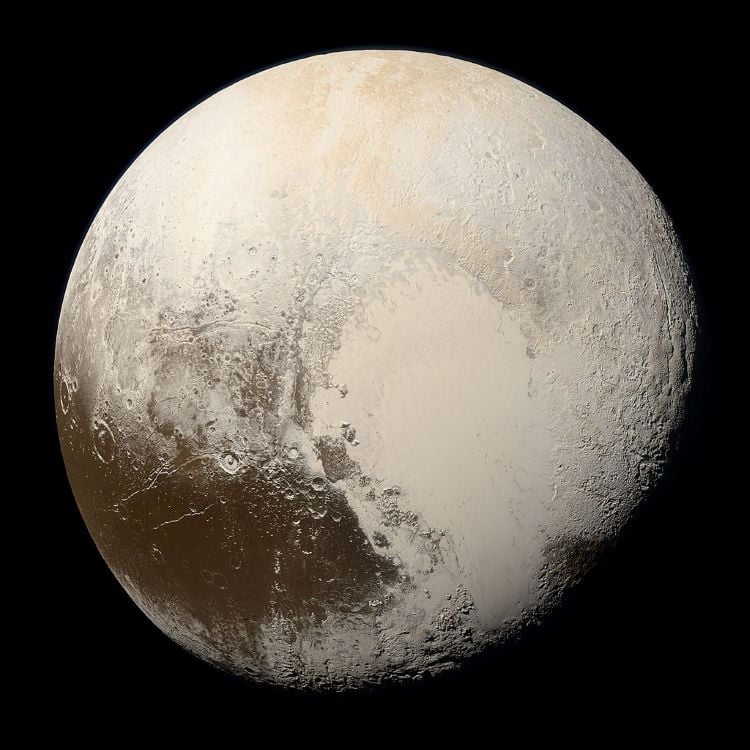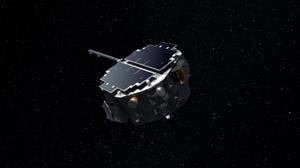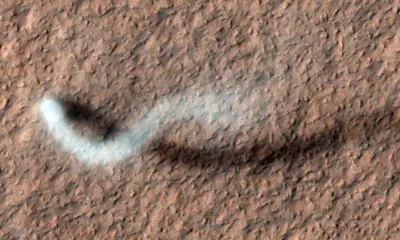Science
Researchers Uncover Signs of Cryovolcanism on Pluto

A recent investigation into cryovolcanism on Pluto has revealed intriguing evidence of geological activity on the distant dwarf planet. Published in *The Planetary Science Journal*, the study focuses on potential cryovolcanic sites, particularly the Kildaze caldera located in Pluto’s Hayabusa Terra region. Researchers aim to understand how geological processes can occur far from the Sun, potentially reshaping our perception of planetary activity in the outer solar system.
To explore this phenomenon, the research team utilized a combination of images from NASA’s New Horizons spacecraft, which made its historic flyby of Pluto in July 2015. By examining the Kildaze caldera, they compared findings with other known cryovolcanic sites on Pluto, such as Virgil Fossae and Viking Terra. They also considered analog sites on Earth, including the Yellowstone and Valles Calderas, as well as Mars sites like the collapsed pit craters in Noctis Labyrinthus.
The researchers employed digital elevation models, elevation profiles, and 3D visualizations to analyze the water ice present in Kildaze. Their findings suggest that the water ice in this region is only a few million years old, indicating that cryovolcanism may still be active on Pluto. The study concludes, “In consideration of the size, structure, composition, and youth of Kildaze and its surroundings, we suggest that this region is a cryovolcano with a caldera structure, having a history of one or more eruptions ejecting 1,000 km³ of cryolava, and possibly an unknown number of eruptions of a smaller scale.”
Cryovolcanism, as opposed to traditional volcanism, involves the movement of icy “magma.” The term was first introduced in 1987, and since then, scientists have observed it on various celestial bodies, including Ceres, Europa, and multiple moons of Saturn and Uranus. Potential triggers for cryovolcanic activity include external impacts, tidal heating from gravitational interactions, or internal heat generated by radioactive decay.
What makes Pluto’s case particularly fascinating is its position as the most distant known planet from the Sun. This raises questions about the sources of its internal heat, as solar influence is likely minimal. Scientists are divided on whether Pluto’s internal heating comes from tidal heating due to interactions with its largest moon, Charon, or from residual heat from its formation billions of years ago. A study published in *Icarus* in 2022 proposed that the interactions with Charon could maintain sufficient heat within Pluto, enabling geological activity.
Since the flyby of New Horizons, which took nearly nine years to reach Pluto, no other spacecraft has visited the dwarf planet. Plans for future missions have been proposed, including an orbiter-lander combination powered by a fusion reactor, which could reach Pluto within four years. In the interim, scientists continue to analyze the wealth of data returned by New Horizons, striving to unlock the mysteries of Pluto’s geological history.
As researchers delve deeper into the implications of cryovolcanism on Pluto, the potential for new discoveries remains high. The findings not only contribute to our understanding of this distant world but also enrich our knowledge of geological processes across the solar system. The exploration of Pluto’s cryovolcanic activity exemplifies the ongoing quest for scientific knowledge and the importance of continued research in planetary science.
-

 Technology5 months ago
Technology5 months agoDiscover the Top 10 Calorie Counting Apps of 2025
-

 Health2 months ago
Health2 months agoBella Hadid Shares Health Update After Treatment for Lyme Disease
-

 Health3 months ago
Health3 months agoErin Bates Shares Recovery Update Following Sepsis Complications
-

 Technology4 months ago
Technology4 months agoDiscover How to Reverse Image Search Using ChatGPT Effortlessly
-

 Technology1 month ago
Technology1 month agoDiscover 2025’s Top GPUs for Exceptional 4K Gaming Performance
-

 Technology2 months ago
Technology2 months agoElectric Moto Influencer Surronster Arrested in Tijuana
-

 Technology5 months ago
Technology5 months agoMeta Initiates $60B AI Data Center Expansion, Starting in Ohio
-

 Technology5 months ago
Technology5 months agoRecovering a Suspended TikTok Account: A Step-by-Step Guide
-

 Health4 months ago
Health4 months agoTested: Rab Firewall Mountain Jacket Survives Harsh Conditions
-

 Lifestyle5 months ago
Lifestyle5 months agoBelton Family Reunites After Daughter Survives Hill Country Floods
-

 Technology4 months ago
Technology4 months agoHarmonic Launches AI Chatbot App to Transform Mathematical Reasoning
-

 Technology3 months ago
Technology3 months agoUncovering the Top Five Most Challenging Motorcycles to Ride





















